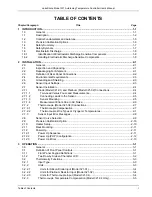
Lake Shore Model 321 Autotuning Temperature Controller User’s Manual
Introduction
1-5
1.2 CONTROL FUNDAMENTALS AND AUTOTUNE
The Model 321 has several features which aid in temperature control of a cryogenic system. These
include standard built-in curves along with the ability to store a single 97 point curve, Serial Interface, a
differential input allowing true four-wire sensor readings, 2 row by 16 character LCD for high visibility,
25 Watt DC current output with short circuit protection of the output, and digital filtering. These and
other features are discussed in detail throughout this manual.
The immediate predecessor of the Model 321 was the Model 320. The Model 320 (along with the Model
330) were the first cryogenic controllers with an Autotuning feature. The Autotuning algorithm
determines the settings of controller gain (
P
roportional), reset (
I
ntegral), and rate (
D
erivative) by
observing the time response of the system upon changes in setpoint under either P, PI, or PID control.
Since this is a digital system, there are inherent limitations associated with digital control and
Autotuning. First, there is the limitation that any control system is inherently unstable if the sampling
rate (frequency) is not greater than twice the system bandwidth (inverse of system time constant). This
is known as the Nyquist criterion. With the current technology used in this controller, i.e., sampling
frequency, etc., digital control is possible for cryogenic system with time constants near or greater than
one second. Fortunately, most cryogenic systems which operate above 1 kelvin will have time
constants that meet this criteria.
The Autotuning function requires that the system time response be measured as a result of a change in
temperature setpoint. In order to get meaningful data for determining the PID parameters, several
points on this response curve must be measured. Consequently, for cryogenic systems where step
responses are less than
≈
5 seconds (where the number of measured points is small), correct
determination of the PID parameters is difficult and better temperature control will normally be achieved
by manual selection of gain and reset (rate will not normally be required). Fortunately, fast cryogenic
systems are not difficult to tune manually.
For slower systems with longer time constants (which can be very difficult to tune manually), Autotuning
can obtain enough information on a step change to characterize the system and determine proper
values of gain, reset, and rate.
There may be other conditions where you will prefer to stay with manual settings. For example, when a
closed cycle refrigerator has very little mass on its second stage and is near its bottom temperature,
attempts at Autotuning may give poor results for control settings due to the large inherent temperature
fluctuations associated with the cooling cycle. Adding mass to the second stage smoothes out these
fluctuations, but lengthens cool-down time.
Lake Shore has simplified the input of the rate time constant in this controller to correspond to a
percentage of the reset time constant, i.e., 0 to 200%. Consequently, if you are in the manual mode and
you set RATE at 100%, on any change in RESET, the controller will automatically calculate the RESET
time constant (999/RESET) and set the RATE time constant at 1/8 of the RESET time constant. This is
one-half the conventional Zeigler-Nichols setting for rate and results in a smaller overshoot of a given
setpoint. Therefore, once RATE is set as a percent, you do not have to worry about updating its value
with setpoint changes resulting in new PI settings. Obviously, if you prefer less RATE, set the rate
setting at something less than 100%. Remember, however, in many cryogenic systems, rate will not be
required anyway, and is consequently set at 0%.
An application note titled
Fundamentals for Usage of Cryogenic Temperature Controllers
is included
with Appendix D. This application note should be read in detail if you are not familiar with cryogenic
temperature controllers.




























